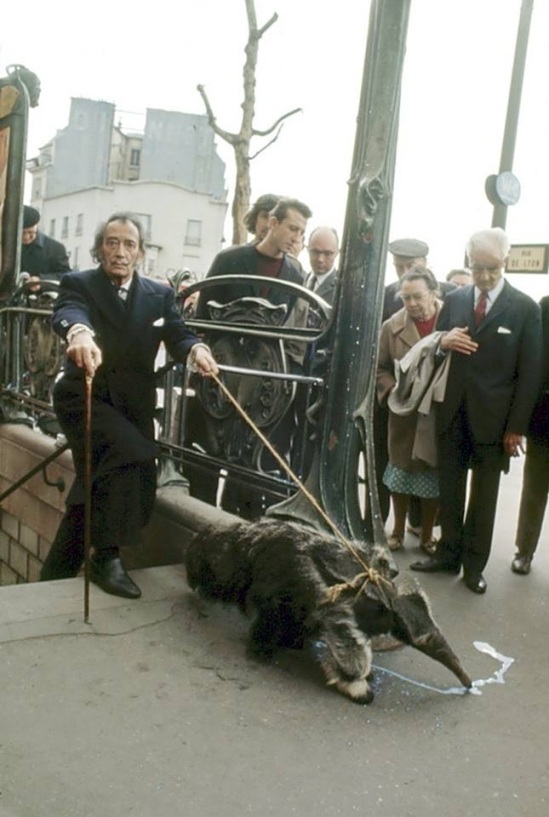
a 1969 photo by an unknown photographer of Salvador Dali walking his anteater in Paris as he comes out of the subway
So maybe Dali, as we in the art world know, is a bit odd and this could be just one of his “regular” oddities. With a little research, however, I was able to uncover the deeper meaning behind this seemingly mundane (for Dali) photograph.
His friend and fellow Surrealist Andre Breton was nicknamed “le tamanoir” which is the french word for anteater. Breton even wrote a poem titled “After the Giant Anteater” in 1931. The poem goes:
Women’s stockings sift the London light*
They quays are stations black with crowds but white with vanished
generations
And when I say London it’s for poetic form
But the women’s stockings are really clock hands
Beneath black mother-of-pearl garters
They belong to something I cannot name
For want of a creature who would be distinct enough from creation
And destruction to lower her own night over my though spinning round
They have been carried into time by space
By female space very different from the other kind and that’s all
Above the stocking is the flesh and on either side of that flesh are bulldogs
Black and white as I said
And still higher the languid game that plays with a handkerchief
Everyone in a circle
And neither higher nor lower the enchanted telegraph wires
Scents confined in vague saucers
There is also a prison that brushes against the air of freedom
This contact engenders the somber flower of passion
That shatters everything in its wake with its fingers of glass
That absorbs the ambient air the breathable air bubble by bubble
And at that elevation perennial strawberries
Are harvested morning and night int he embers
That open onto pleasure in an agate star
The armor here shows so charming a flaw
Such old earth with its pink crust becomes desirable
That words leap over the cliffs with all their roots shining
And seek the tenderest part of the ear
The electric grass has momentarily lain down
The light deflects even the ask of the eye
That remains open as if before the impossible
This flower that would be the morning-and-evening-glory
Strength and weakness drop their equipment nearby
And already the amazing feat begins
Then the dagger-colored dramas the comedies shaped like scarves
Rise by one note
And far away in the woods the future between two branches
Begins to quiver like the unappeasable absence of a leaf
Here the two pans of the scale the two sides of the hearth
Take turns submitting to the deprivation of evaluating and seeing
I think of the Great Bear but it is not she
I would like minors to understand me
And ivy to heed what I’m saying
The abrupt line the treacherous gap of fire that uncovers its face
Will be but a call of the devil in the abstract city
Toward the unswearable reign of the crackling
Nameless woman
Who smashes the jewel of this day into a thousand shards
-André Breton 20 May 1931
The same year, Dali painted The Persistence of Memory which featured ants, his symbol for decay. Just two years later, he produced a film with Luis Bunuel titled “Un chien d’andalou” which infamously featured an eye being slit open and ants crawling out of a man’s arm. He would continue to use ants through his work in various mediums and even sketched anteaters such as André Breton as a Great Anteater (1929-31).

Later in life, Dali appeared on the Dick Cavett Show along side Lillian Gish on March 6, 1970 carrying an anteater on a leash and tossed it in the actresses lap. Scholars claim that he hated ants ever since he was a child and found them eating the dead body of his pet bat when he was a boy. This developed into his affinity for the anteater.
Although the clip of him from the Dick Cavett Show is impossible to find, I will leave you with two other clips of Salvador Dali from popular TV shows of his time.
Sources
Wikipedia contributors. “The Dick Cavett Show.” Wikipedia, The Free Encyclopedia. Wikipedia, The Free Encyclopedia, 6 Oct. 2014. Web. 8 Oct. 2014.
Lockwood, Jeffrey. The Infested Mind: Why Humans Fear, Loathe, and Love Insects. New York: Oxford University Press, 2013. Print.